#tane-mahuta
Photo
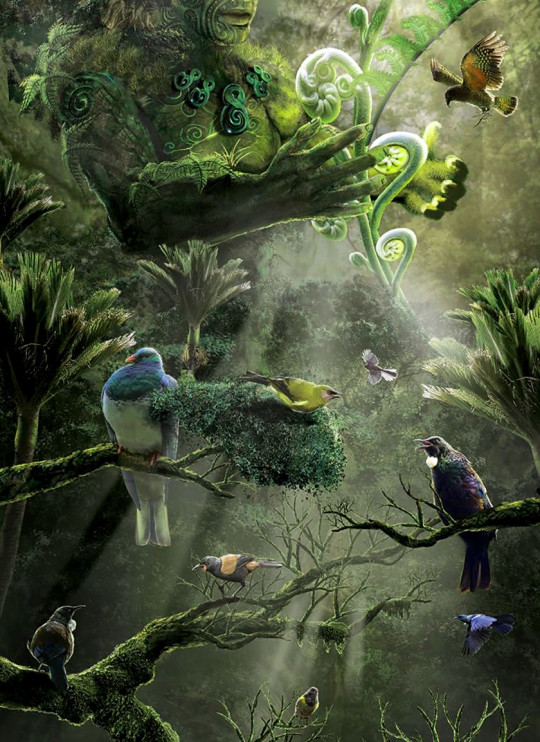
Legends and myths about trees
Legendary tree deities (15)
Tāne – god of forests & birds in Maori mythology
Tāne (or Tāne-mahuta) is a figure of great importance in iwi traditions. First, he separated earth and sky and brought this world into being. Also, he fashioned the first human. Furthermore, he adorned the heavens, and brought the baskets of knowledge, wisdom, and understanding down from the sky to human beings.
Some legends say that Tāne was trying to find himself a wife, but at first he found only non-human females and fathered a collection of mountains, reptiles, or grass and stones. Then he made a woman by moulding her from the soil, named Tiki.
He is the son of Rangi and Papa, the sky father and the earth mother, who used to lie in a tight embrace where their many children lived in the darkness between them.
Their children grew frustrated at their confinement in the cramped space between their parents. Tū, future god of war, proposes that they should kill their parents. But Tāne disagrees, suggesting that it is better to separate them, sending Rangi into the sky and leaving Papa below to care for them.
Tāne's brothers Rongo, then Tangaroa, Haumia-tiketike and Tū all try in vain to separate the parents. After many tries, Tāne lies on his back and pushes with his strong legs, and finally forces his parents apart, and Rangi rises high into the heavens. Thus the sky and the earth were divided. Then Tāne searched for heavenly bodies as lights so that his father would be appropriately dressed. He obtained the stars and threw them up, along with the moon and the sun. At last Rangi looked handsome.
Tāne Mahuta, also called "God of the Forest", is a giant kauri tree (Agathis australis) in the Waipoua Forest of Northland Region, New Zealand. Its age is unknown but is estimated to be between 1,250 and 2,500 years. It is the largest living kauri tree known to stand today. It is named for Tāne, the Māori god of forests and of birds.
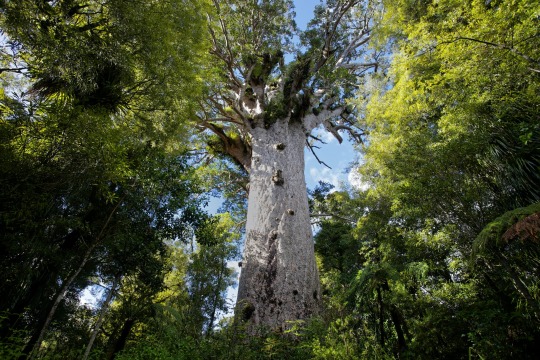
木にまつわる伝説・神話
伝説の樹木の神々 (15)
ターネ〜 マオリ神話の森と鳥の神
ターネ (またはターネ・マフタ) は、イウィの伝統の中で非常に重要な人物である。まず、大地と空を分け、この世界を誕生させた。また、最初の人間を造った。さらに、天を飾り、天から知識、知恵、理解の籠を人間に下ろしてきた。
伝承によれば、ターネは自分に妻を見つけようとしていたが、最初は人間以外の雌しか見つけられず、生まれてくるものは山の集まりや爬虫類だったり、草や石などだった。そして、土から成形して女性を作り、ティキと名付けたという。
彼はランギとパパの息子で、空の父と大地の母が固く抱き合い、その間の暗闇にたくさんの子供たちが住んでいた。
その子どもたちは、両親の間の狭い空間に閉じ込められていることに不満を募らせる。未来の軍神であるトゥーは、両親を殺すことを提案する。しかし、ターネはそれに反対し、ランギを空に飛ばし、パパを下に置いて自分たちの世話をするのがよいと提案する。
トゥーを先頭に、ターネの兄弟のロンゴ、タンガロア、ハウミア・ティケティケは、両親を引き離そうとするが、なかなかうまくいかない。何度も試した末、ターネは仰向けになり、力強い足で押し、ついに両親を引き離し、ランギは天高く昇っていく。こうして天と地が分かれた。そしてターネは、天体を明かりとして探した。父親の服装を整えるためである。彼は星を手に入れ、月や太陽と一緒に投げ上げた。そしてついにランギは端正な姿になった。
「森の神」とも呼ばれるターネ・マフタは、ニュージーランド、ノースランド地方のワイポウア森林保護区にあるカウリの巨大な大木 (アガチス・アウストラリス) のことである。樹齢は不明だが、1,250年から2,500年と推定されている。現存するカウリの木としては最大のものである。マオリ族の森と鳥の神、ターネにちなんで名づけられた。
#trees#tree legend#tree myth#legend#mythology#folklore#tane-mahuta#tane#maori mythology#god of forest#waipoua forest#philosophy#nature#art
142 notes
·
View notes
Photo




Tane Mahuta, the biggest Kauri tree (45.2m high, up to 2,500yrs old) and Te Matua Ngahere, the oldest and second biggest Kauri tree (29.9m high, up to 4000yrs old).
Waipoua Forest, New Zealand
#tane mahuta#kauri#kauri tree#tree#forest#rainforest#new zealand#travel#te matua ngahere#biggest tree#oldest tree#koru#fern
12 notes
·
View notes
Video
youtube
The Ruby Suns - Tane Mahuta
2 notes
·
View notes
Text
Australian fakemon: birds
Continuing with my fakemon region based on Australia and Aotearoa/New Zealand with some bird Pokemon. I'll admit, this region is primarily based on Australia with a bit of NZ, like how Paldea is primarily Spain but with a bit of Mexico and Brazil. This entry, however, is very New Zealandy. The islands of Aotearoa/New Zealand are very interesting in terms of biology as they are or were home to tons of unique birds. Prior to humans introducing dogs, rats, and the like, birds were the dominant vertebrates of the islands.
Previous posts: starters, more starters, misc 1, misc 2, and early-game standards
For my early-game bird line I took a bit of a challenge. I wanted to make an early-game normal/flying bird and make it interesting. I'll let you judge if I succeeded.
The first stage is Kakawiet, the Silent Pokemon, Normal-type. It is normal rather than normal/flying because it is flightless. Kakawiet are drab, flightless, and unable to make a single sound. While they live a boring existence, every Kakawiet dreams of being a performer and this dream urges them to grow strong and evolve. Kakawiet is based on the Kakapo, a flightless parrot from Aotearoa/NZ. Like the Kakapo, it is flightless and a drab green. Its name comes from "Kakapo" and "quiet"

Kakawiet evolves into Kakaphony, the Loud Pokemon, normal/flying type. Having evolves, Kakaphony is one step closer to achieving its dream of being a performer. It can fly, has become brightly colored, and can finally sing. Having just gained a voice, Kakaphony is not very good at singling, but insists on doing so loudly and frequently, much to the frustration of humans trying to sleep. The more they practice, they better they get and a Kakaphony that becomes good at singing will evolve. Kakaphomy is based on parakeets, more specifically, the Australian Budgerigar, which has become a popular pet. It also takes some inspiration from the elaborate decorations found on some birds of paradise, some species of which are found in Australia. Its name comes from "kakapo" and "cacophony".

The final stage is Orkakastra, the Performer Pokemon, normal/flying type. Only a few Kakaphony gain the skill at sing and dance needed to evolve. They are master auteurs, capable of making performances that can inspire even the most jaded of minds. To see an Orkakastra in action is a sight none will forget. Trainers need to learn to control their Orkakastras, as a poorly-trained one will often drop whatever it's doing when inspiration for a ner performance strikes it. Orkakastra is primarily based on cockatoos, which can be found through the Australasian region. It also has the color scheme of a rainbow lorikeet, a bird found in south Australia. Notably, the birds that inspired this design, the kakapo, parakeet, lorikeet, and cockatoo are all parrots. Orkakastra's head crest is based on the ones poosessed by cockatoos, but I also wanted it to look like the silhouette of the Sydney Opera House to add an extra layer of performing arts inspiration. Its name comes from "kakapo" and "orchestra". This line (at least the second two stages) would have an ability that increased the power of sound-based moves. Combined with STAB, this would let moves like Hyper Voice do great neutral damage and is the reason I made the line normal types.

If you're making Aotearoa/New Zealand Pokemon, how can you avoid doing a kiwi (bird) as a kiwi (fruit). Meet Hokakiwi, the Kiwi Pokemon, grass-type. While it looks like a bird, Hokakiwi is actually a large fruit. Legends say that somewhere deep in the forest is a tree that grows all Hokakiwi. Because many Pokemon enjoy the taste of Hokakiwi, they are shy and reclusive creatures that are rarely seen. The hard skin of the shell body protects them and they can withdraw their heads when in danger. I partially based Hokakiwi and its evolution on the Maori legend of how the kiwi lost its wings. In the story, the tree god Tane-Mahuta realizes that bugs are eating his trees so he asks the bird god Tane-Hokahoka (note that I found multiple names for these characters from multiple sources) to get a bird to eat the bugs. Tane-Hokahoka asks all the birds if they will give up their wings to live on the ground and eat bugs and only the Kiwi agrees to do it. Each stage in this evolution line uses the names of one of the gods. Hokakiwi comes from "Tane-Hokahoka" and "Kiwi". I considered making it a grass/rock or grass/ground type to reference England's Bulford kiwi chalk hill figure, but decided I need more mono-types.

Hokakiwi evolves to Moahuta, the moa Pokemon, grass-type. After evolving, Moahuta became so large and sturdy that most Pokemon can't hunt it. Free from the fear its previous stage had, Moahuta has become a prideful giant that strides through the land without fear. Its only predator is Poukakire (see below) and the sight or sound of one drives Moahuta into an intense panic that will cause it to drop its haughty attitude and do anything to escape. Moahuta is based on moas, giant flightless birds that once lived in Aotearoa/New Zealand until the first human inhabitants hunted them to extinction. Adult moas are believed to have had only one natural predator, the Haast's Eagle, which will come up again. While Hokakiwi was based on a kiwi fruit, Moahuta is based on a dragonfruit. This is mostly because I think dragonfruits look cool, but they have been imported to NZ as a crop. Moahuta's name comes from "moa" and "Tane-Mahuta". I see it being a defensive mon like Tangrowth.
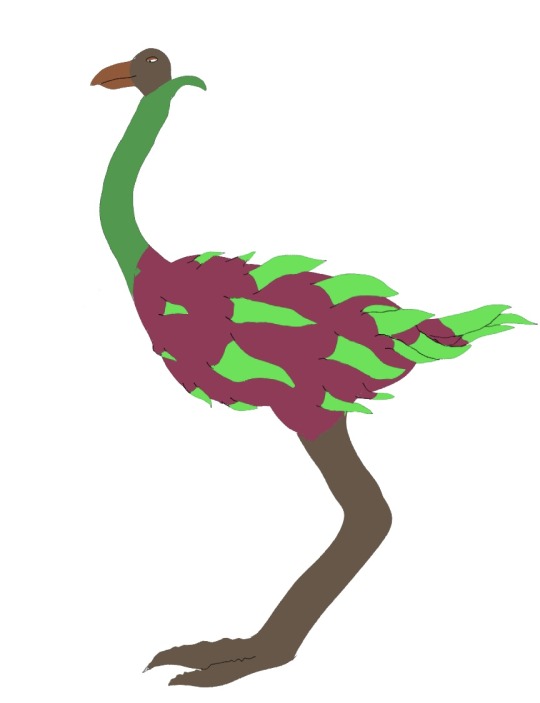
The final line starts with Snowai, the Snow Eaglet Pokemon, ice/flying type. Snowai need to be incubated in extremely cold temperatures so their nests are only found at the tops of tall mountains. After hatching, the mother will make each chick a snowball they they will live inside until evolution. Snowai are weak and ungainly and rarely leave their nests. Because of this, they are very rarely seen, but their cries echo across the mountains and can be heard miles away. People used to think the cries were omens of bad luck due to not knowing their origins. Snowai is based on a Haast's eagle chick. Haast's eagle is an extinct species of giant eagle from Aotearoa/New Zealand that hunted moas. They went extinct after the extinction of the moa destroyed their primary food source. Snowai is also based on the mythical hakawai, a bird who was never seen but its call could be heard and symbolized bad luck. Some anthropologists have suggested that the hakawai may be based on cultural memories of the Haast's eagle. Snowai's name comes from "snowball" and "hakawai".
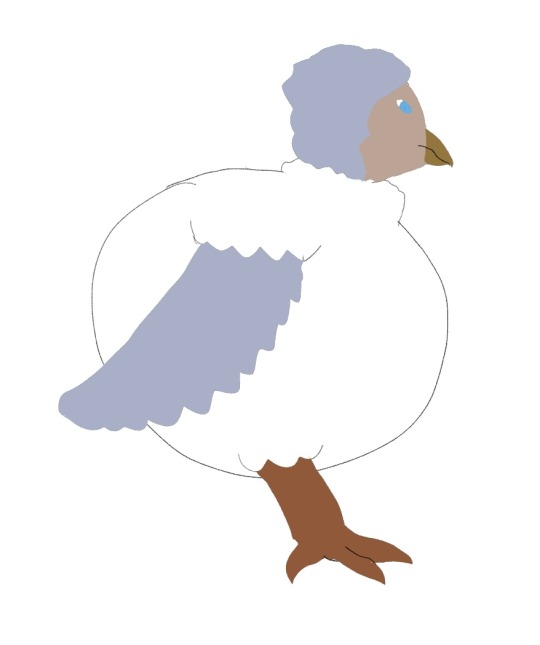
Snowai evolves to Poukakiri, the Ice Eagle Pokemon, ice/flying type. Masters of the skies of the Goorda Region, nothing on the ground is safe from a hunting Poukakiri, but their preferred prey is Moahuta. Poukakiri lives in the snowy mountains and only comes down to hunt, so they are rarely seen and many legends have grows of them descending from the sky and carrying off humans. It is said that if the air suddenly becomes colder, a Poukakiri is flying overhead and you should get inside to be safe. While fierce hunters, Poukakiri are also caring parents who dedicate themselves to raising their weak Snowai offspring until they can evolve and hunt on their own. Poukakiri is based on an adult Haast's eagle and the legendary poukai, a bird from Maori legend that would carry off humans to eat. The poukai is possibly based on cultural memories of the Haast's eagle, who could easily have killed a human if it wanted too. Poukakiri's name comes from "poukai" and "makakiri", a Maori word for "cold" or "winter". I view this line as being akin to Magikarp in that you have to raise a weak first stage to evolve it into a powerful second stage.
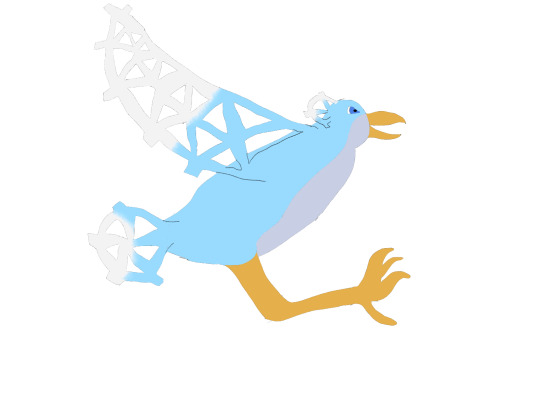
#pokemon#fakemon#australia#aotearoa#new zealand#bird#birds#kakapo#budgie#parakeet#rainbow lorikeet#cockatoo#kiwi#moa#haast's eagle#eagle#maori mythology#art#novice artist#new artist
9 notes
·
View notes
Text
Why were so many of Harold's cousins including current Kiwi/Māori BRF family members in LoS - excluded from the Harkle's wedding?
Hi All,
One of the issues that came up at the time of the Harkle's wedding - was that apart from only Harry's closest cousins - such as Princess Eugenie and Beatrice, were invited to the wedding, a large part of his family was also excluded. As we know - the wedding was largely lavishly paid for by (now) King Charles III - and there are many traditions and an extremely long standing one is that the wider cousinage are invited to Royal events. This caused quite a lot of upset apparently. The late Queen Elizabeth II was very close to her cousins, for example, such as the Duke of Gloucester and his wife, who are active working Royals, and their children and grandchildren, who represent the Queen and put in many decades of hard work to supporting her, and they had a close relationship.Great Granddaughter of King George V, Daughter of Duke of Gloucester (Queen's Cousin), Lady Dalvina Windsor, her Kiwi/Māori husband Gary Lewis, and their two children (both in the LoS) were excluded from the Harkle's 2018 wedding.
For example, the late Queen was close to her cousins, such as for example the Duke of Gloucester, who is a full time working Royal, some of whom live on the Royal estate - and so they are always invited to, and seen at important Royal events - for example, at the chapel at wedding of Prince William and Princess Catherine, the Trooping of the Colour, the Queen's funeral and so on.Granddaughter of the Duke of Gloucester, Senna Kowhai Lewis - with her cousins Prince George and Princess Charlotte at Trooping the colour.
There were many celebrities - some of which openly admitted to having met the Harkles once, who were sitting in the innermost chapel. In total 600 guests were invited to the ceremony and reception. They also invited over 2,000 other individuals - some random members of the public - were invited to attend outside the chapel at Windsor castle.
As a New Zealander/ person from Aotearoa, I find it upsetting and disrespectful that our 'kiwi'/Māori Royals were excluded from the Harkle's wedding - especially since it was a public event and they are normally invited to all the public events.
Current BRF members excluded by MM and Prince Harry - including BRF members of 'mixed race'
I also find it frustrating that MM would claim to be the first 'person of colour' marrying into the BRF. While there are also historical examples this, there are already current members of the BRF from different cultures. For example, the family of Lady Davina Windsor (who was born 10th in line to the throne) - i.e. the same current place as Beatrice's first born.
In 2004, Lady Davina Windsor married handsome Māori bulding contractor, master builder, sheep shearer (and surfer) Gary Lewis (he is also nephew to famous author Whiti Ihimaera). They were married for many years. I really liked how they both seemed so down to earth and hard working, also how they named their two children traditional Māori names (Tane Mahuta - named after the sacred Kauri tree) and Senna Kowhai - Kowhai is a beautiful Spring blossom, who are also in the line of succession.
Long before anyone had heard of MM, the Queen happily gave her consent to the marriage, and apparently, he was widely liked and warmly welcomed and described by his parents in law, as a wonderful catch.
Sadly, the cultural differences became too much, and they aren't together anymore (separating in 2019), but they seem to be amicably separated. The family are still part of all official Royal events for instance, the late Queen's funeral and Trooping the Color.
The whole family seems so normal and nice, it's not easy to find information as they certainty didn't seem to court publicity. I still think it was not nice/disrespectful of the Harkles to exclude them (and the other cousins) from the wedding.
It does also make me wonder if the Harkle's decision to exclude them from their wedding was due to the fact that it pointed out that MM is most definitely not the first person of mixed heritage to marry into the BRF (which already includes family members with British family royal blood).
Post link
author: narcwatchkiwi
submitted: September 15, 2023 at 04:51AM via SaintMeghanMarkle on Reddit
#saintmeghanmarkle#sussexes#markled#archewell#harry and meghan#meghan markle#prince harry#megxit#duke and duchess of sussex#duchess of sussex#harry and meghan smollett#walmart wallis#harkles#megain#spare by prince harry#fucking grifters#archetypes with meghan#meghan and harry#heart of invictus#invictus games#i am invictus#finding freedom#doria ragland#waaagh#narcwatchkiwi
9 notes
·
View notes
Text
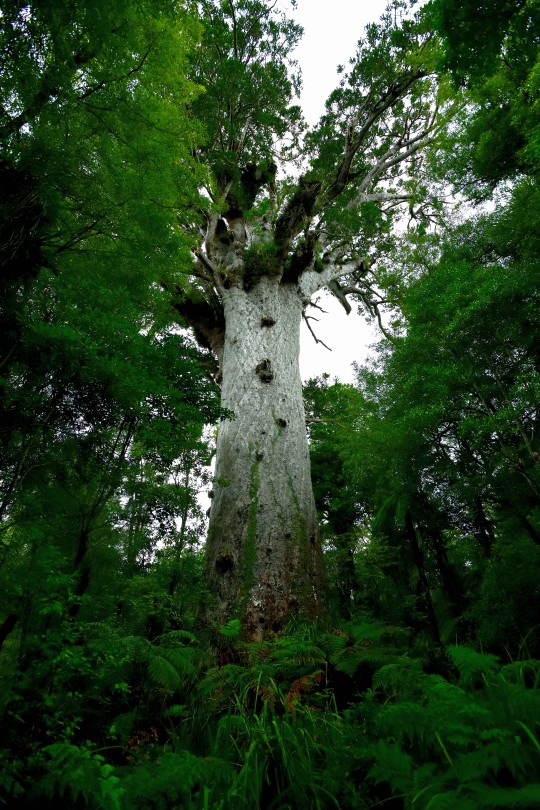
Tane Mahuta - Lord of the Forest - New Zealand
#new zealand#photographers on tumblr#original photography#original photograph#original photographer#my photograph#nikon
5 notes
·
View notes
Text
instagram
Hinenuitep.
Hinenuitep is a goddess of night and she receives the spirits of humans when they die. She is the daughter of Tane Mahuta / Tane Tuturi and Hine-ahuone. It is believed among Maori that the color red in the sky comes from her. Hine nui te Po Shepherds the Wairua/souls into the first level of Rarohenga to ready them for the next stage of their journey
If you like this piece, please check out my deviant art! Link is in the bio!
2 notes
·
View notes
Text
Aroha Nz
this is my song,
my love song of you,
my land, my heart
love for green ferns
silver beneath
volcanic lakes so deep
taniwha never disturbed
tane mahuta
ancestral wisdom
sings his love
of freedom
of power listen O dwellers
for the great king's ways
this is my song,
my love song of you,
my land, my heart
mountains lifted to snow
lovingly protect greenstone below
rocks and grasses bear wind
centuries blown
tiers of bush
house birds of cheek
keas that wreck
anything loose
kiwi flightless night worm hunters
listen as little ruru calls
'morepork morepork'
love for the swamplands
full of raupo and pukeko
flaxes edge all
tall sentinels bearing
bearing beloved tui nectar
spears
this is my song
my love song of you
my land, my heart
love soars high
to black sand beaches
constant companions
to white thrashing surf
merging with stony clear
eel filled rivers
love surges forth to oceans of
silver muscled kawhai
delights for stomach and eye
birds of sky and sea
gather love to me
this is my song
my love song of you
my land my heart
Virginia Waters, 2018
0 notes
Text
Ranger - Department of Conservation - Wellington
Maintain tracks and facilities in some beautiful locations in the wider Wellington region, including Makara, Orongorongo Valley, Otaki Forks, Kapiti Island and Matiu Somes Island and many more.
Enjoy keeping fit, plenty of variety and love working in the outdoors?
Four weeks and three days annual leave per year.
Permanent full time, Porirua location.
Toitu te marae a Tane-Mahuta, toitu te marae…

View On WordPress
0 notes
Photo

Legends and myths about trees
Legendary tree deities (16)
Hākuturi – The avian people, the guardians of the forest
In Māori mythology, the hākuturi are guardians of the forest. They are responsible for guarding the forest, and to avenge any desecration of its sacredness. When Rātā cut down a tree without first making the proper incantations and rituals, the hākuturi rebuked him by re-erecting the tree. When he showed remorse, they felled the tree again and made it into a canoe for him in a single night, which was name Tuirangi. The hākuturi seem to have been regarded as birds or birdlike. Some believe that hākturi the children of Tāne (Ref), god of the forest and ancestor of birds.

木にまつわる伝説・神話
伝説の樹木の神々 (16)
ハークトゥリ 〜 森の番をする鳥人間
マオリ神話では、ハークトゥリとは森の守護者。彼らは森を守り、その神聖さを冒涜するものには復讐する責任を負っている。ラーターが呪文や儀式を行わずに木を切り倒したとき、ハークトゥリたちはラーターを叱りつけ、再び木を立てた。彼が反省すると、再び木を切り倒し、一晩で彼のためにカヌーを作り、それを「トゥイランギ」と名付けた。ハークトゥリは森の神であり鳥の祖先であるターネ(参照)の子どもたちであるという説もある
#trees#tree legend#tree myth#legend#mythology#folklore#hakuturi#maori mythology#forest guardian#avian humanoid#tane-mahuta#tane#nature#art
131 notes
·
View notes
Text
WEEK 3
Task 3 - SITE and ARTWORK DIGITAL VISUALISATION
With the use of Photoshop, this first image was an experiment to see what the iterated crystal ball sculpture from the Task 1 (Line and Direction) would look like if it were placed within an environment that had similar qualities. The planar surface of the rock became a perfect base for the sculpture to be placed on. The layered roots from the tree are wrapped in a flowy direction around the rock containing the sculpture even more. This creates more visual tension and emphasizes the fragility of the wire and crystal ball spatial work.
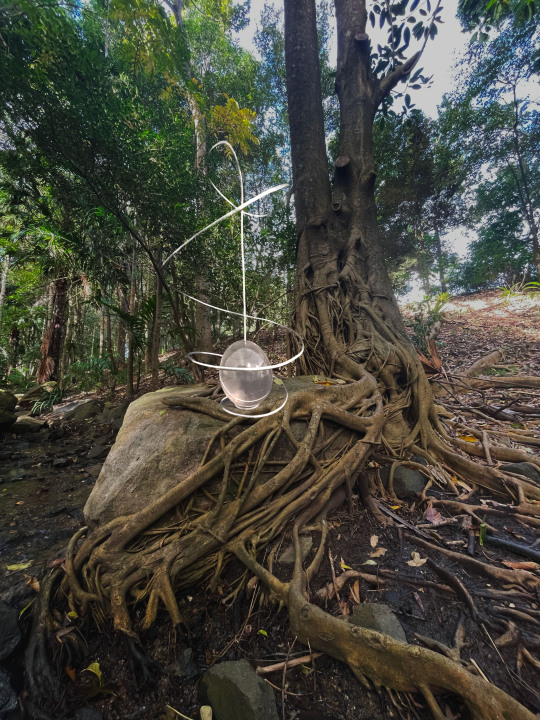
Task 3 - SITE and ARTWORK DIGITAL VISUALISATION
This second image utilizes the artwork from Task 2 (Plane and Balance) from the use of Fibre Board. This Planar sculpture was then photoshopped into a photograph of the Kholo Gardens located in the West Brisbane Region in Muirlea.
https://www.ipswich.qld.gov.au/explore/parks_reserves_precincts/parks_search/kholo-gardens
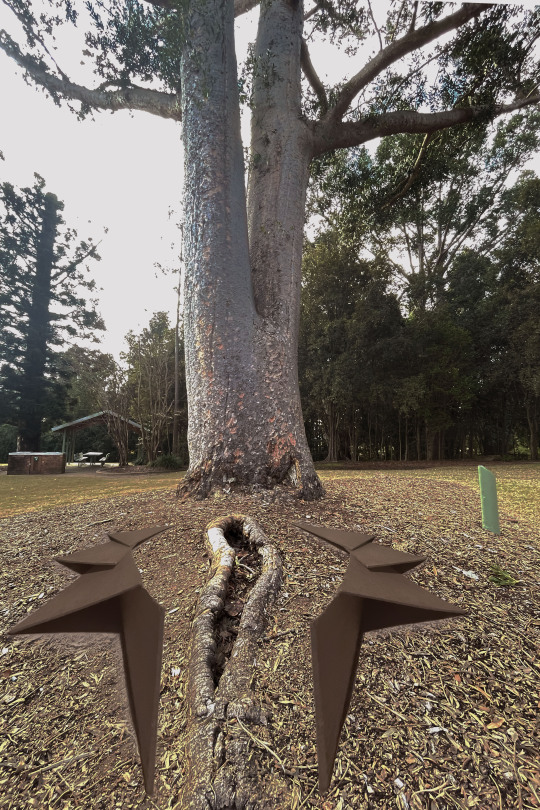
The artwork was doubled, mirrored, and fanned out over the ground framing a split open tap root of a Kauri tree. The two composite rows were then skewered into perspective adding a realistic vision of a spatial work. The contrast was also adjusted and the shadows were softened using a brush to minimize any harsh contours.
REFLECTION
This Image became a prototype of a possible outcome for large-scale spatial artwork on a site-specific location around a specific tree. The work draws emphasis on the organic architecture of an environment and the way in which the root is vulnerable and exposed.
Kauri trees, or Agathis australis, are native to New Zealand and have a long history and spiritual significance for the Maori people. They are one of the oldest and largest trees in the world, dating back to the Jurassic period. They symbolize the creation of space for life to flourish, as they shed their branches and bark to prevent other plants from invading their territory. The kauri’s spirit inspires us to act on our creative potential and explore new possibilities for growth.
"Kauri is the Maori name for Agathis australis, trees that are native to New Zealand. A giant kauri tree called Tane Mahuta, or “Lord of the Forest” is estimated to be between 1,250 to 2,500 years old. In the Maori creation myth, Tane Mahuta is the son of Ranginui the sky father, and Papatuanuka the earth mother who embraced each other so tightly that their children struggled to grow. Eventually, Tane summoned his inner strength and separated his father from his mother to create enough space for the light to shine in. He held this space open until his mother was clothed in flora and fauna. The birds and animals became his children. This story of the kauri’s spirit exemplifies the importance of creating space for life to grow."
by Laural Virtues Wauters 08/06/2023.
The two arched rows of tessellated natural fiber boards are placed around a split open tap root exposed from the ground. This visual planar, symmetry, and repetition of the work draws significant attention to the split tree root and its relationship it has with the sun. It reflects the symbolic and cultural perspectives of the Maori people and the spiritual qualities of the strong and resilient Kauri tree. The work exemplifies the importance of creating space for life to grow allowing more light to shine in.
0 notes
Text
W3: SDL - x5 - Specialist Knowledge
Screen-printing, Painting, Digital Illustrations,
Screen-printing:
Tane Mahuta - Aotearoa Liberation Poster by Xavier Meade 2009
Two beautiful Screen-printed posters from New Zealand showing the relevance and use of screen-printing in graphic design, even though it is primarily used for clothing design.
Found through DigitalNz -> Ehive. And DigitalNZ -> Te Papa Museum


Links: https://ehive.com/collections/8668/objects/1152447/tane-mahuta-aotearoa-liberation-poster
Illustration:
Unity in isolation, illustrations. By Kunal Parekh, 2020, Auckland Libraries.
2. Digital Painting Techniques, Book from 2015 - Wallace Jackson
These books can help me improve my knowledge and creative library on digital illustration. The second book can help me to improve my own techniques and learn about using digital painting within my design practice. Digital Painting goes hand in hand with illustration.
Found through AUT Library -> Springer Books. And DigitalNZ.org
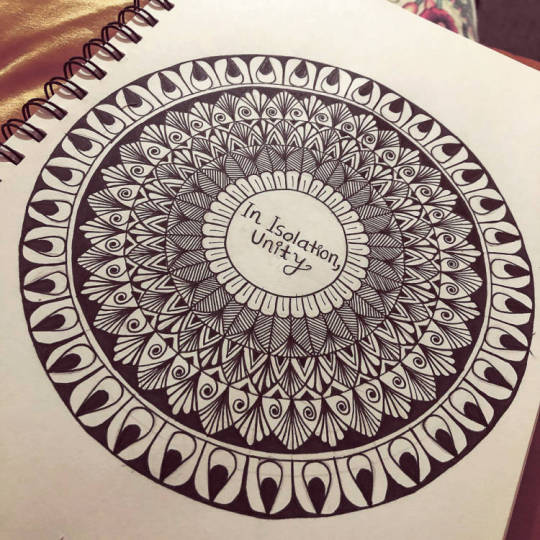

Photography:
Visual archaeologies of photography, 2013. National Library of New Zealand.
This book presents a selection of modern day daguerreotype, tintypes, polaroids, and other forms of photography created during the digital era but using techniques from bygone eras.
0 notes
Text
C'est déjà notre dernière journée ensemble avec Clochette 😭😭
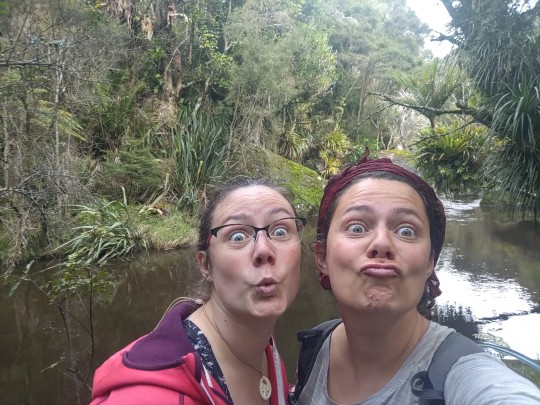
On a commencé par devoir faire un détour d'une heure et demie, la route principale étant toujours bloquée depuis le cyclone d'il y a 4 mois (je ne veux même pas imaginer les dégâts)... Nous en avons donc profité pour passer par la "90 miles beach", une plage qui longe le littoral sur une centaine de kilomètres ! On y a trouvé ce charmant petit personnage :

Si je ne me trompe pas, il s'agit d'un Man o' War, une galère portugaise. C'est un peu l'équivalent du sumac, mais version animal marin : sa brûlure peut être douloureuse pendant des semaines ... On l'a laissé bien tranquille hein !

Ensuite, on est parties se balader dans les rochers géants de Wairere ! (Il y avait même une grotte de dragon, et des maisons de fées, eh ouais !)
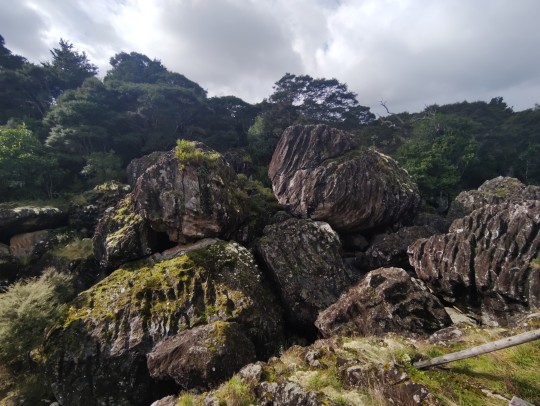
C'est assez marrant : vous voyez les grandes rainures sur leur surface ? En fait, c'est à cause des Kauris (les grands arbres) du coin : ils acidifient assez fortement le sol. Du coup, quand l'eau acide coule sur les rochers, elle finit par le ronger ! Bon, apparemment, il faut à peu près 1000ans pour qu'une goutte d'eau finisse par laisser une trace, vous voyez donc là le travail des dernières 2,8millions d'années. Rien que ça. Ça demande de la patience l'art géologique 😎
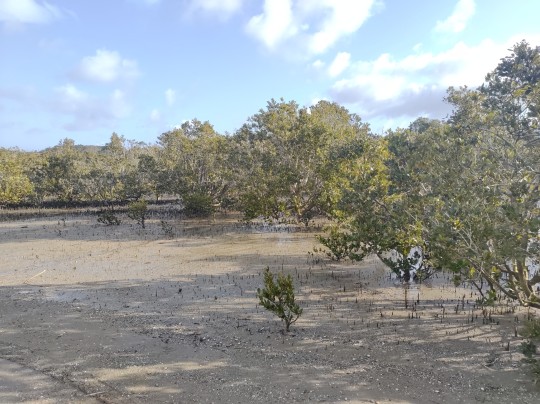
Ensuite, on a tenté d'aller trouver les Koutu Boulders, qui sont censés être de gros rochers en bord de mer ... On a donc trouvé la mangrove ci dessus (les branches qui sortent du sol, c'est normal, les arbres poussent directement comme ça ! Ça fait super bizarre, mais ils ne se sont pas enfoncés dans le sol, on en voit souvent dans les zones marécageuses le long des routes et ça ressemble toujours à ça)... Et les majestueux rochers ci dessous.
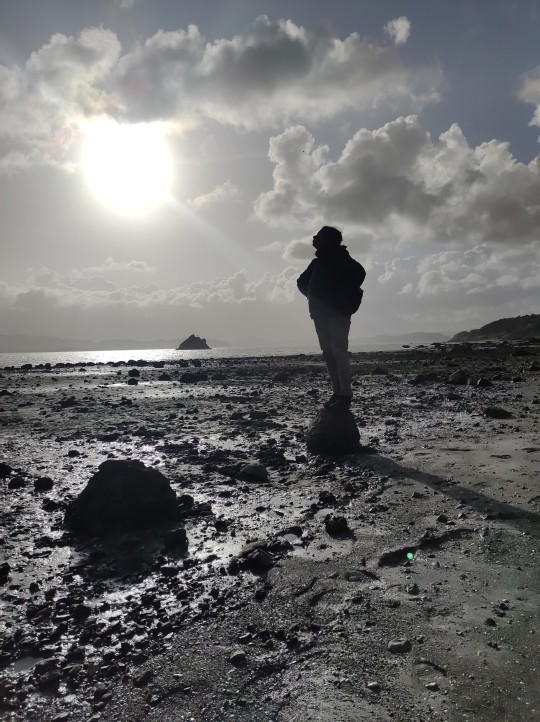
Voilà voilà, après la crise de fou rire terminée, nous avons donc repris le volant, direction le majestueux Kauri Tane Mahuta. Alors, majestueux, certes ... Mais surtout fermé >.<
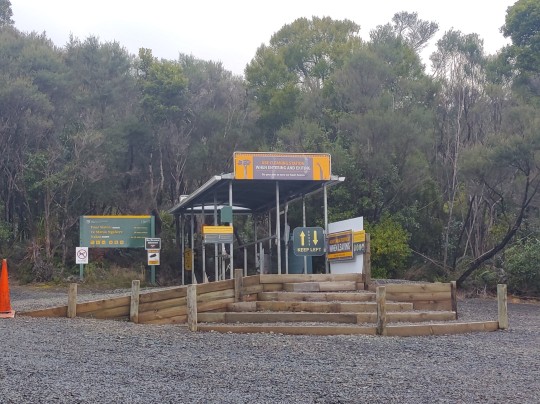
J'en profite pour vous montrer les stations de nettoyage des chaussures qu'on trouve à l'entrée de toutes les promenades en forêt ici : il faut brosser et désinfecter ses chaussures à l'entré et à la sortie pour éviter de contaminer les kauris avec le Dieback, une maladie sans traitement qui leur est mortelle.
Heureusement pour nous, l'accès à son voisin Te Matua Ngahere était lui bon ouvert ! 1 bon kilomètre à se balader entre les arbres gigantesques, c'était quelque chose ... (On vous a mis une Touille pour l'échelle !)
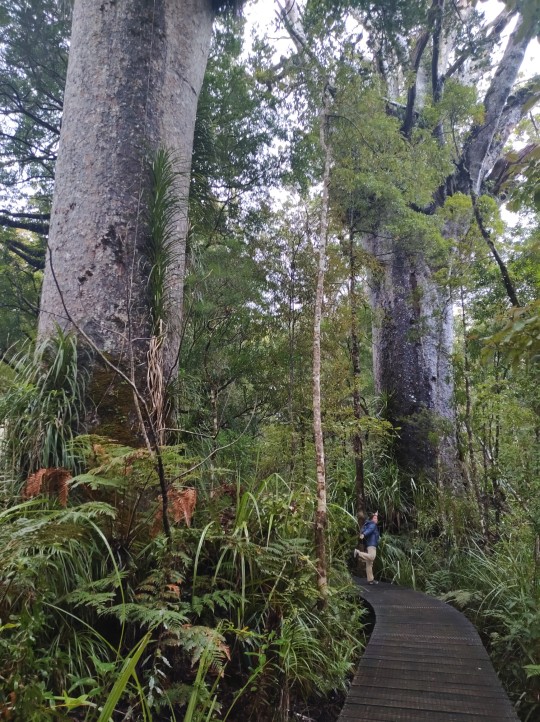
Notre objectif final, c'était donc le Père de la forêt (noter la majuscule), un vénérable ancêtre de 16m de circonférence, 30m de haut ... Et 3000ans d'âge. Rien que ça.
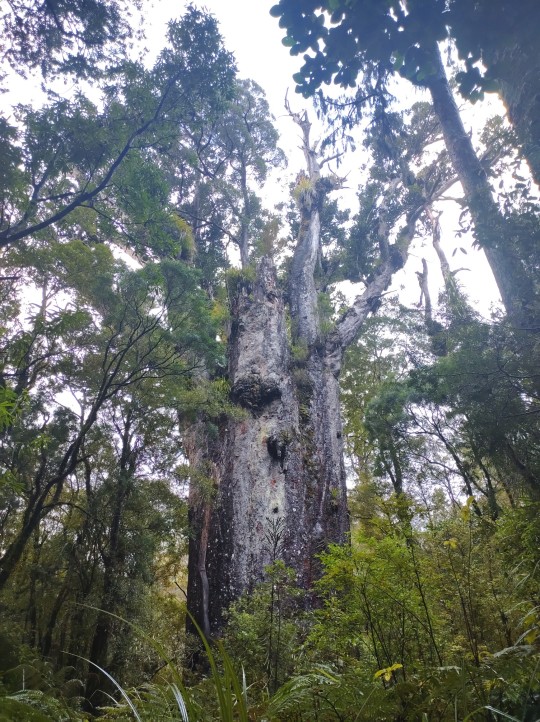
On a ensuite fini la journée en se mangeant une bonne pizza devant un bon film, calées dans le van ... C'était vraiment un mois super 🥰
Ps : en bonus, une photo des dunes d'hier, avec une Touille en échelle. Voui, c'est le pixel noir là... Et encore, on était déjà très largement à mi hauteur sur cette photo !
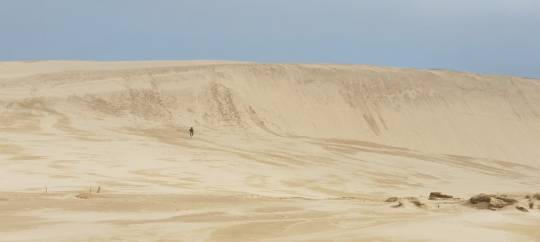
0 notes
Text
Review of contextual knowledge
Rongoā Māori practitioner Donna KerridgeAfter taking out the following books, I have realised that there are so many different leaves and remedies.
So I thought to focus on a topic like burnout and then choose some remedies that can help with burnout like plants that can help with headaches, muscle soreness, or a good nights sleep, and maybe it approach it that way so that there is a focused area for me to research about.
The books that I have are below :)

By Tom Paul (1987)
This book’s narrative is written in a first person POV and Tom talks about his journey and his interest in rongoa maori. He was born in Taumaranui and lived in Mananui, and learnt a lot of knowledge from his grandmother, Wikura Tanoa. He then introduces the mythological story of Tane mahuta (the god of the forest) and how Tane provided Maori with food, warmth and shelter through his resources.
The subject that is focused on in this book is survival of maori and how they lived from nature pre-colonial times. (Which now has me thinking that it will be a good idea to focus on a specific area where rongoa has helped people and only focus on thos specific remedies to guide me)

“Medicines of the Māori” by Christina Macdonald (1974)
My initial thought was “Why is someone who is not Maori writing about something that is needs to be written by Maori?” but as I read through it, I became so proud that this person has genuinely done their research and spoken to the right people to be able to execute this book.
Macdonald writes in a more scholarly article way where she is the observer of all of this knowledge. She first talks about the arrival of Maori, and where we set sail from before landing in Aotearoa. (How cool that she knows this??) Macdonald then continues to write about the different materials used to make food, drink water and where Maori stalled food. She then goes into introducing rongoa, and one specifically that took interest to me was “medicinal steam baths” and talks about a specific tree called “Fuchsia” or “Kōtukutuku” in te reo māori. And is known to grow between the regions of Auckland and Rotorua. Macdonald then further speaks about more plants, their maori names and what they do with illustrations next to them.
I noticed the paper smelt and felt very nostalgic with a cream and almost card like feel, which I actually enjoyed.

By Rob McGowan (2009)
McGowan’s book is more of a “practical guide” to Maori medicine (rongoa maori) The book is made up of two sections: The first speaks about the foundation of rongoa maori, traditional maori medicine. It talks about the fundamental understandings that are the basis of rongoa.
The second section focuses on the practical aspects of learning about rongoa maori and how to use it. It deals with identifying the plants you might want to use, their harvesting and preparation.
This book to me feels like a if you want to persoanlly participate in rongoa maori, this is how you do it. Which is like a interactive way of writing. He’s used gloss paper and has used photography to portray the different plants and rongoa.
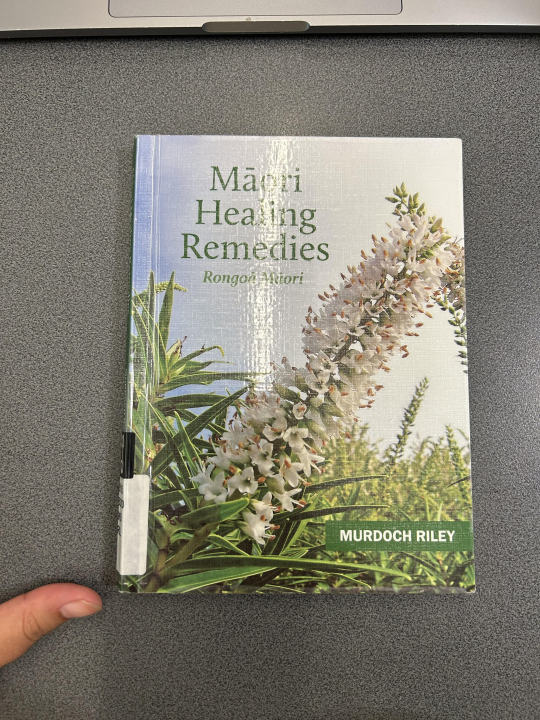
By Murdoch Riley (n.d)
This book focues on how to use Māori herbal remedies to cure common medical problems. Riley also mentions he has avoided using plants that no longer exists in this book or are extremely difficult to access.
The book is made from a thick paper and Riley has used photography to portray the plants with a description next to them
Two web stories:
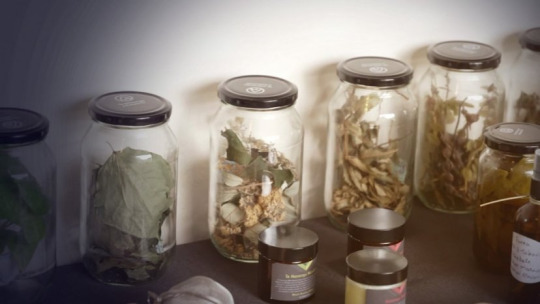
Rongoā Māori practitioners fear their work and treatments will be disadvantaged by the Therapeutic Products Bill, with grave concerns from practitioner Renee MacDonald that the bill will diminish traditional Māori healing methods, to the same effect the Tohunga Suppression Act did.
https://www.teaomaori.news/concerns-rongoa-maori-disadvantaged-new-bill
Rongoā Māori practitioner Donna Kerridge
Donna Kerridge talks about the Rongoā Māori courses she will be taking in Dannevirke which will provide an introduction to Māori medicine and healing concepts while exploring the importance of re-connecting to the land. Video Warren Buckland
https://www.nzherald.co.nz/hawkes-bay-today/video/rongoa-maori-practitioner-donna-kerridge/KQTD3JYXQSRMY7BFGGBQROETWU/
0 notes
Text
Te Kete The Basket - Das Körbchen
For Mattea and Robert
27 August 2022 & 4 February 2023
Tane Mahuta
The ancestor of all the living trees
Gave birth to the Harakeke
Millions of years passed until 1992
The month of April to be exact
When a rito was born way down south
On an island of the South Pacific
At nearly the same time
A Peacock
was born high up in the woods of Vienna, Austria.
The Harakeke and the Peacock grew strong but apart
Surrounded by family and friends
The Peacock in a mountain fortress
The Harakeke on the island stronghold
Thousands of miles of distance
A call from across the seas
Leaving the mountain and island
At Lancaster
Where the Peacock sensed the beautiful Harakeke
And the Peacock gave one of his feathers as a gift
A sign of a long everlasting life which time will not fade
And so began
A weaving together of the Harakeke and the Peacock feather
Once started, the magic work could not be stopped
A Kete was, and is, being created
It is a whole new living thing
We have all received the gifts from this love
Our opportunity today
Is to give gifts to support and acknowledge
This Kete is like a wandern rucksack full of essential items
You can call upon them in future days
It is the plate of the harakeke from where you were born. This is the symbol of your families, the nest from which you depart
From the breath of Tawhirimatea. Fresh air from the skies of New Zealand and Austria. It is the breath of life
Water is the symbol of refreshment. This water comes from springs high in the mountains of New Zealand and Austria. With this water we give our blessing
This stone was formed over long a time. Gaining colour and strength within the earth. The stone is our wish for stability, strength and a long and happy life
This candle holds the fire, the flame of love. Never to be extinguished. May it shine brightly in your life
The fern or koru is the symbol of new beginnings, growth and change. Every day is an opportunity for a fresh start
The tui is a talkable, chatter box bird. Reminding us about communication, keeping it free and open
We can’t do without food especially chocolate. Cherish moments you have together over a meal
Lastly sand from Plimmerton Beach and the banks of the River Danube. Your grandparents walked here and walk still. Our ancestors continue to guide our lives
And every grain of sand is counted by God who cares for us
For now at last you are beginning Chapter One of the Great Story which no one on earth has read or lived: which goes on forever: in which every chapter is better than the one before. (C.S. Lewis)
Ma te Atua koutou e manaaki, e tiaki, ake ake ake
Amene
0 notes